Latitudinal Differences in Spread F Characteristics at Asian Longitude Sector during the Descending Phase of the 24th Solar Cycle
Abstract
:1. Introduction
2. Instrument and Dataset
3. Results
4. Discussion
5. Conclusions
- Our statistical results show that SF mainly occurred at night, and the RSF occurrence rate decreased with the increase in latitude at the equinox, while the FSF occurrence rate was the opposite in summer. FSF was the most prevalent type at all three stations with the maximum occurrence rate occurring after midnight, while the maximum occurrence rate of RSF and SSF occurred mainly before midnight. FSF occurred earlier at LS station and the mean time delay of the initial time of FSF among the three stations was about 2 h.
- The importance of plasma bubbles at the equator and nighttime MSTID at middle latitudes on RSF and FSF generation has been recognized, respectively.
- The investigation of the statistical features of SF occurrence could have a significant impact on the design and deployment of modern communication systems.
Author Contributions
Funding
Institutional Review Board Statement
Informed Consent Statement
Data Availability Statement
Acknowledgments
Conflicts of Interest
References
- Booker, H.G.; Wells, H.W. Scattering of radio waves by the F-region of the ionosphere. J. Geophys. Res. 1938, 43, 249–256. [Google Scholar] [CrossRef]
- Shi, J.K.; Wang, G.J.; Reinisch, B.W.; Shang, S.P.; Wang, X.; Zherebotsov, G.; Potekhin, A. Relationship between strong range spread F and ionospheric scintillations observed in Hainan from 2003 to 2007. J. Geophys. Res. 2011, 116, A08306. [Google Scholar]
- Bowman, G.G. A relationship between ‘‘spread-F” and the height of the F2 ionospheric layer. Aust. J. Phys. 1960, 13, 69–72. [Google Scholar] [CrossRef]
- Hajkowicz, L.A. Morphology of quantified ionospheric range spread-F over a wide range of midlatitudes in the Australian longitudinal sector. Ann. Geophys. 2007, 25, 1125–1130. [Google Scholar] [CrossRef]
- Bowman, G.G. Short-term delays (hours) of ionospheric spread F occurrence at a range of latitudes, following geomagnetic activity. J. Geophys. Res. Space Phys. 1998, 103, 11627–11634. [Google Scholar] [CrossRef]
- Dabas, R.S.; Das, R.M.; Sharma, K.; Garg, S.C.; Devasia, C.V.; Subbarao, K.S.V.; Rama Rao, P.V.S. Equatorial and low latitude spread-F irregularity characteristics over the Indian region and their prediction possibilities. J. Atmos. Sol. Terr. Phys. 2007, 69, 685–696. [Google Scholar] [CrossRef]
- Alfonsi, L.; Spogli, L.; Pezzopane, M.; Romano, V.; Zuccheretti, E.; De Franceschi, G.; Cabrera, M.A.; Ezquer, R.G. Comparative analysis of spread-F signature and GPS scintillation occurrences at Tucuman, Argentina. J. Geophys. Res. Space Phys. 2013, 118, 4483–4502. [Google Scholar] [CrossRef]
- Zhu, Z.P.; Lan, J.P.; Luo, W.H.; Sun, F.L.; Chen, K.; Chang, S.S. Statistical characteristics of ionogram spread-F and satellite traces over a Chinese low-latitude station Sanya. Adv. Space Res. 2015, 56, 1911–1921. [Google Scholar] [CrossRef]
- Lan, T.; Jiang, C.; Yang, G.; Zhang, Y.; Liu, J.; Zhao, Z. Statistical analysis of low-latitude spread F observed over Puer, China during 2015–2016. Earth Planets Space 2019, 71, 138. [Google Scholar] [CrossRef]
- Pimenta, A.A.; Fagundes, P.R.; Bittencourt, J.A.; Sahai, Y. Relevant aspects of equatorial plasma bubbles under different solar activity conditions. Adv. Space Res. 2001, 27, 1213–1218. [Google Scholar] [CrossRef]
- Sahai, Y.; Fagundes, P.R.; Bittencourt, J.A. Trans-equatorial F region ionospheric plasma bubbles: Solar cycle effects. J. Atmos. Sol. -Terr. Phys. 2000, 62, 1377–1383. [Google Scholar] [CrossRef]
- Abdu, M.A.; Sobral, J.H.A.; Nelson, O.R.; Batista, I.S. Solar cycle related range type spread-F occurrence characteristics over equatorial and low latitude stations in Brazil. J. Atmos. Terr. Phys. 1985, 47, 901–905. [Google Scholar] [CrossRef]
- Kumar, S. Morphology of equatorial plasma bubbles during low and high solar activity years over Indian sector. Astrophys. Space Sci. 2017, 362, 93. [Google Scholar] [CrossRef]
- Burke, W.J.; de La Beaujardière, O.; Gentile, L.C.; Hunton, D.E.; Pfaff, R.F.; Roddy, P.A.; Su, Y.J.; Wilson, G.R. C/NOFS observations of plasma density and electric field irregularities at post-midnight local times. Geophys. Res. Lett. 2009, 36, L00C09. [Google Scholar] [CrossRef]
- Dungey, J.W. Convective diffusion in the equatorial F region. J. Atmos. Sol. Terr. Phys. 1956, 9, 304–310. [Google Scholar] [CrossRef]
- Fejer, B.G.; Scherliess, L.; de Paula, E.R. Effects of the vertical plasma drift velocity on the generation and evolution of equatorial spread F. J. Geophys. Res. Space Phys. 1999, 104, 19859–19869. [Google Scholar] [CrossRef]
- Madhav Haridas, M.K.; Manju, G.; Arunamani, T. Solar activity variations of Equatorial Spread F occurrence and sustenance during different seasons over Indian longitudes: Empirical model and causative mechanisms. Adv. Space Res. 2018, 61, 2585–2592. [Google Scholar] [CrossRef]
- Li, G.; Ning, B.; Abdu, M.A.; Yue, X.; Liu, L.; Wan, W.; Hu, L. On the occurrence of post-midnight equatorial F region irregularities during the June solstice. J. Geophys. Res. 2011, 116, A04318. [Google Scholar]
- Zhan, W.; Rodrigues, F.; Milla, M. On the genesis of post-midnight equatorial spread F: Results for the American/Peruvian sector. Geophys. Res. Lett. 2018, 45, 7354–7361. [Google Scholar] [CrossRef]
- Sun, L.; Xu, J.; Zhu, Y.; Xiong, C.; Yuan, W.; Wu, K.; Hao, Y.; Chen, G.; Yan, C.; Wang, Z.; et al. Interaction between an EMSTID and an EPB in the EIA crest region over China. J. Geophys. Res. Space Phys. 2021, 126, e2020JA029005. [Google Scholar] [CrossRef]
- Das, T.; Paul, K.S.; Paul, A. Observation of ionospheric irregularities around midnight and post-midnight near the northern crest of the equatorial ionization anomaly in the Indian longitude sector: Case studies. J. Atmos. Sol. Terr. Phys. 2014, 121, 188–195. [Google Scholar] [CrossRef]
- Yokoyama, T.; Pfaff, R.F.; Roddy, P.A.; Yamamoto, M.; Otsuka, Y. On post-midnight low-latitude ionospheric irregularities during solar minimum: 2. C/NOFS observations and comparisons with the Equatorial Atmosphere Radar. J. Geophys. Res. Space Phys. 2011, 116, A11. [Google Scholar]
- Paul, K.S.; Haralambous, H.; Oikonomou, C.; Paul, A.; Belehaki, A.; Ioanna, T.; Kouba, D.; Buresova, D. Multi-station investigation of spread F over Europe during low to high solar activity. J. Space Weather. Space Clim. 2018, 8, A27. [Google Scholar] [CrossRef] [Green Version]
- Wang, N.; Guo, L.; Ding, Z.; Zhao, Z.; Xu, Z.; Xu, T.; Hu, Y. Longitudinal differences in the statistical characteristics of ionospheric spread-F occurrences at midlatitude in Eastern Asia. Earth Planets Space 2019, 71, 1–15. [Google Scholar] [CrossRef]
- Singleton, D.G. The morphology of spread-F occurrence over half a sunspot cycle. J. Geophys. Res. 1968, 73, 295–308. [Google Scholar] [CrossRef]
- Perkins, F. Spread F and ionospheric currents. J. Geophys. Res. 1973, 78, 218–226. [Google Scholar] [CrossRef]
- Abdu, M.A. Outstanding problems in the equatorial ionosphere–thermosphere electrodynamics relevant to spread F. J. Atmos. Sol. Terr. Phys. 2001, 63, 869–884. [Google Scholar] [CrossRef]
- Huang, C.S.; Miller, C.A.; Kelley, M.C. Basic properties and gravity wave initiation of the midlatitude F region instability. Radio Sci. 1994, 29, 395–405. [Google Scholar] [CrossRef]
- Haldoupis, C.; Kelley, M.C.; Hussey, G.C.; Shalimov, S. Role of unstable sporadic-E layers in the generation of midlatitude spread F. J. Geophys Res. 2003, 108, 2. [Google Scholar]
- Candido, C.M.N.; Batista, I.S.; Becker-Guedes, F.; Abdu, M.A.; Sobral, J.H.A.; Takahashi, H. Spread F occurrence over a southern anomaly crest location in Brazil during June solstice of solar minimum activity. J. Geophys. Res. 2011, 116, A06316. [Google Scholar] [CrossRef]
- Jiang, C.H.; Yang, G.B.; Liu, J.; Yokoyama, T.; Komolmis, T.; Song, H.; Lan, T.; Zhou, C.; Zhang, Y.N.; Zhao, Z.Y. Ionosonde observations of daytime spread F at low latitudes. J. Geophys Res. Space Phys. 2016, 121, 12093–12103. [Google Scholar] [CrossRef]
- Jiang, C.H.; Yang, G.B.; Liu, J.; Zhao, Z.Y. A study of the F2 layer stratifcation on ionograms using a simple model of TIDs. J. Geophys. Res. Space Phys. 2019, 124, 1317–1327. [Google Scholar] [CrossRef]
- Pimenta, A.A.; Kelley, M.C.; Sahai, Y.; Bittencourt, J.A.; Fagundes, P.R. Thermospheric dark band structures observed in all-sky OI 630 nm emission images over the Brazilian low-latitude sector. J. Geophys. Res. 2008, 113, A01307. [Google Scholar] [CrossRef]
- Krall, J.; Huba, J.D.; Ossakow, S.L.; Joyce, G.; Makela, J.J.; Miller, E.S.; Kelley, M.C. Modeling of equatorial plasma bubbles triggered by non-equatorial traveling ionospheric disturbances. Geophys. Res. Lett. 2011, 38, L08103. [Google Scholar] [CrossRef]
- Yao, M.; Chen, G.; Zhao, Z.; Wang, Y.; Bai, B. A novel low-power multifunctional ionospheric sounding system. IEEE Trans. Instrum. Meas. 2012, 61, 1252–1259. [Google Scholar] [CrossRef]
- Nozaki, K. FMCW Ionosonde for the SEALION project. J. Natl. Inst. Inf. Commun. Technol. 2009, 56, 287–298. [Google Scholar]
- Fejer, B.G. The electrodynamics of the low-latitude ionosphere: Recent results and future challenges. J. Atmos. Sol. Terr. Phys. 1997, 59, 1456–1482. [Google Scholar] [CrossRef]
- Hysell, D.L.; Burcham, J.D. Long term studies of equatorial spread F using the JULIA radar at Jicamarca. J. Atmos. Sol. Terr. Phys. 2002, 64, 1531–1543. [Google Scholar] [CrossRef]
- Gentile, L.C.; Burke, W.J.; Rich, F.J. A global climatology for equatorial plasma bubbles in the topside ionosphere. Ann. Geophys. 2006, 24, 163–172. [Google Scholar] [CrossRef]
- Rangaswamy, S.; Kapasi, K.B. Equatorial spread-F and solar activity. J. Atmos. Terr. Phys. 1964, 26, 871–878. [Google Scholar] [CrossRef]
- Stoneback, R.A.; Heelis, R.A.; Burrell, A.G.; Coley, W.R.; Fejer, B.G.; Pacheco, E. Observations of quiet time vertical ion drift in the equatorial ionosphere during the solar minimum period of 2009. J. Geophys. Res. 2011, 116, A12327. [Google Scholar] [CrossRef]
- Manju, G.; Sreeja, V.; Ravindran, S.; Thampi, S.V. Toward prediction of L band scintillations in the equatorial ionization anomaly region. J. Geophys. Res. Space Phys. 2011, 116, 307–315. [Google Scholar] [CrossRef]
- Wang, G.J.; Shi, J.K.; Reinisch, B.W.; Wang, X.; Wang, Z. Ionospheric plasma bubbles observed concurrently by multi-instruments over low-latitude station Hainan. J. Geophys. Res. Space Phys. 2015, 120, 2288–2298. [Google Scholar] [CrossRef]
- Cherniak, I.; Zakharenkova, I. First observations of super plasma bubbles in Europe. Geophys. Res. Lett. 2016, 43, 11137–11145. [Google Scholar] [CrossRef]
- Huang, C.-S.; de La Beaujardiere, O.; Pfaff, R.F.; Retterer, J.M.; Roddy, P.A.; Hunton, D.E.; Su, Y.-J.; Su, S.-Y.; Rich, F.J. Zonal drift of plasma particles inside equatorial plasma bubbles and its relation to the zonal drift of the bubble structure. J. Geophys. Res. 2010, 115, A07316. [Google Scholar] [CrossRef]
- Sastri, J.H. Letter to the Editor: Post-midnight onset of spread-F at Kodaikanal during the June solstice of solar minimum. Ann. Geophys. 1999, 17, 1111–1115. [Google Scholar]
- Heelis, R.A.; Stoneback, R.; Earle, G.D.; Haaser, R.A.; Abdu, M.A. Medium-scale equatorial plasma irregularities observed by coupled ion-neutral dynamics investigation sensors aboard the communication navigation outage forecast system in a prolonged solar-minimum. J. Geophys. Res. 2010, 115, A10321. [Google Scholar] [CrossRef]
- Ding, F.; Wan, W.X.; Xu, G.R.; Yu, T.; Yang, G.L.; Wang, J.-S. Climatology of medium-scale traveling ionospheric disturbances observed by a GPS network in central China. J. Geophys. Res. 2011, 116, A09327. [Google Scholar] [CrossRef]
- Bhaneja, P.; Earle, G.D.; Bullett, T.W. Statistical analysis of midlatitude spread F using multi-station digisonde observations. J. Atmos. Sol. Terr. Phys. 2018, 167, 146–155. [Google Scholar] [CrossRef]
- Miller, E.S.; Makela, J.J.; Kelley, M.C. Seeding of equatorial plasma depletions by polarization electric fields from middle latitudes: Experimental evidence. Geophys. Res. Lett. 2009, 36, L18105. [Google Scholar] [CrossRef]
- Candido, C.M.N.; Pimenta, A.A.; Bittencourt, J.A.; Becker-Guedes, F. Statistical analysis of the occurrence of medium-scale traveling ionospheric disturbances over Brazilian low latitudes using OI 630.0 nm emission all-sky images. Geophys. Res. Lett. 2008, 35, L17105. [Google Scholar] [CrossRef]
- Huang, F.; Lei, J.; Dou, X.; Luan, X.; Zhong, J. Nighttime medium-scale traveling ionospheric disturbances from airglow imager and Global Navigation Satellite Systems observations. Geophys. Res. Lett. 2018, 45, 31–38. [Google Scholar] [CrossRef]
- Chen, G.Y.; Zhou, C.; Liu, Y.; Zhao, J.Q.; Tang, Q.; Wang, X.; Zhao, Z.Y. A statistical analysis of medium-scale traveling ionospheric disturbances during 2014–2017 using the Hong Kong CORS network. Earth Planets Space 2019, 71, 52–66. [Google Scholar] [CrossRef]
- Kil, H.; Paxton, L.J. Global distribution of nighttime medium-scale traveling ionospheric disturbances seen by Swarm satellites. Geophys. Res. Lett. 2017, 44, 9176–9182. [Google Scholar] [CrossRef]
- Hines, C.O. Internal atmospheric gravity waves at ionospheric heights. Can. J. Phys. 1960, 38, 1441–1481. [Google Scholar] [CrossRef]
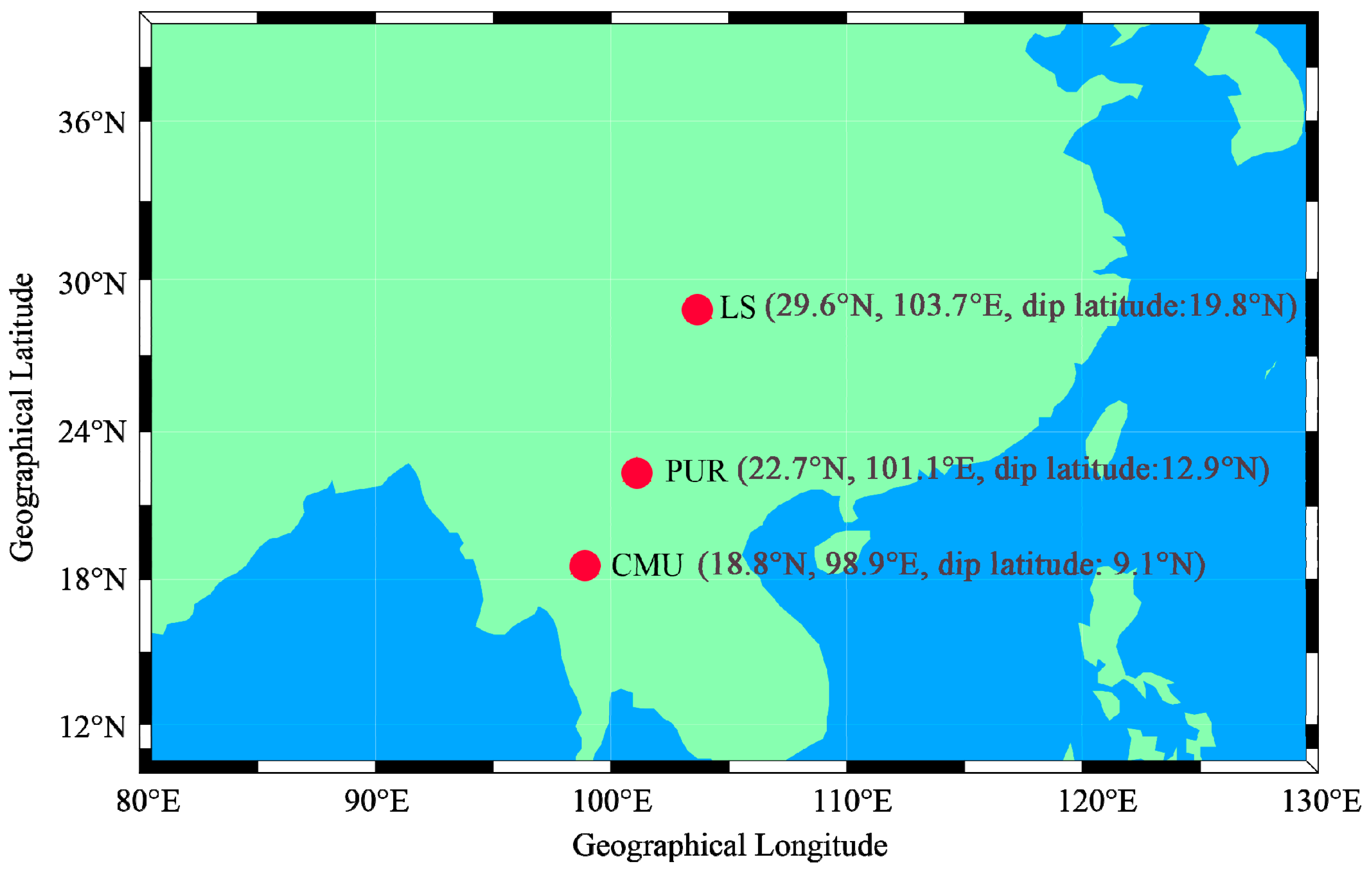
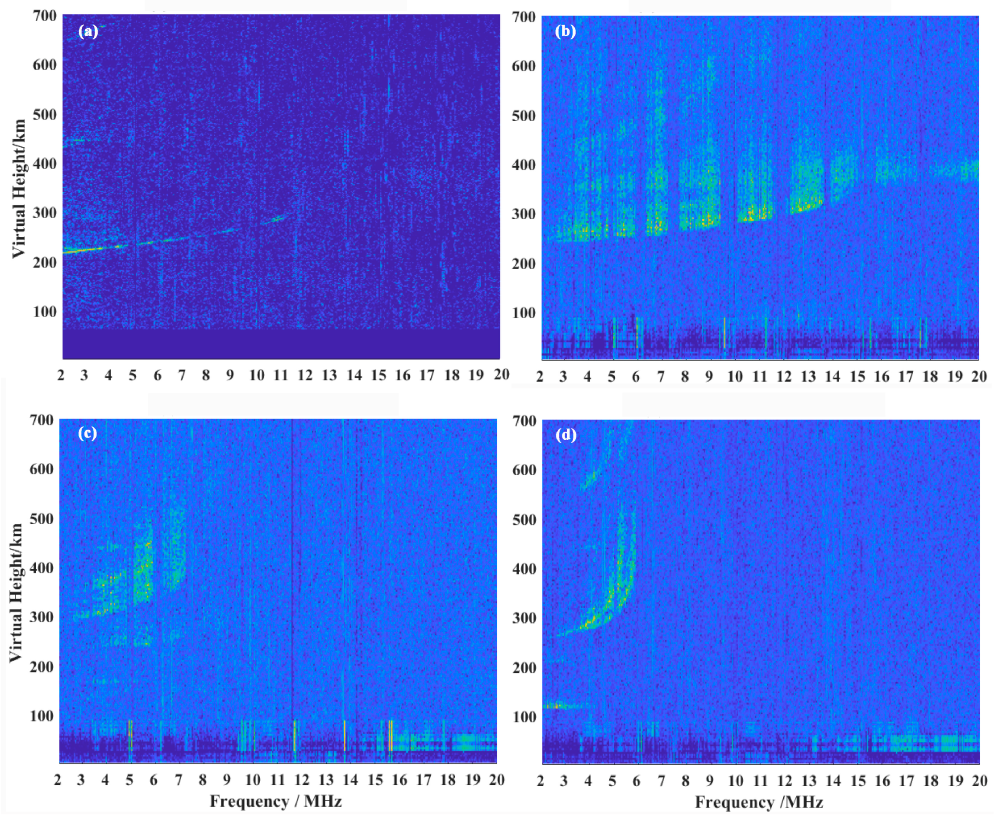
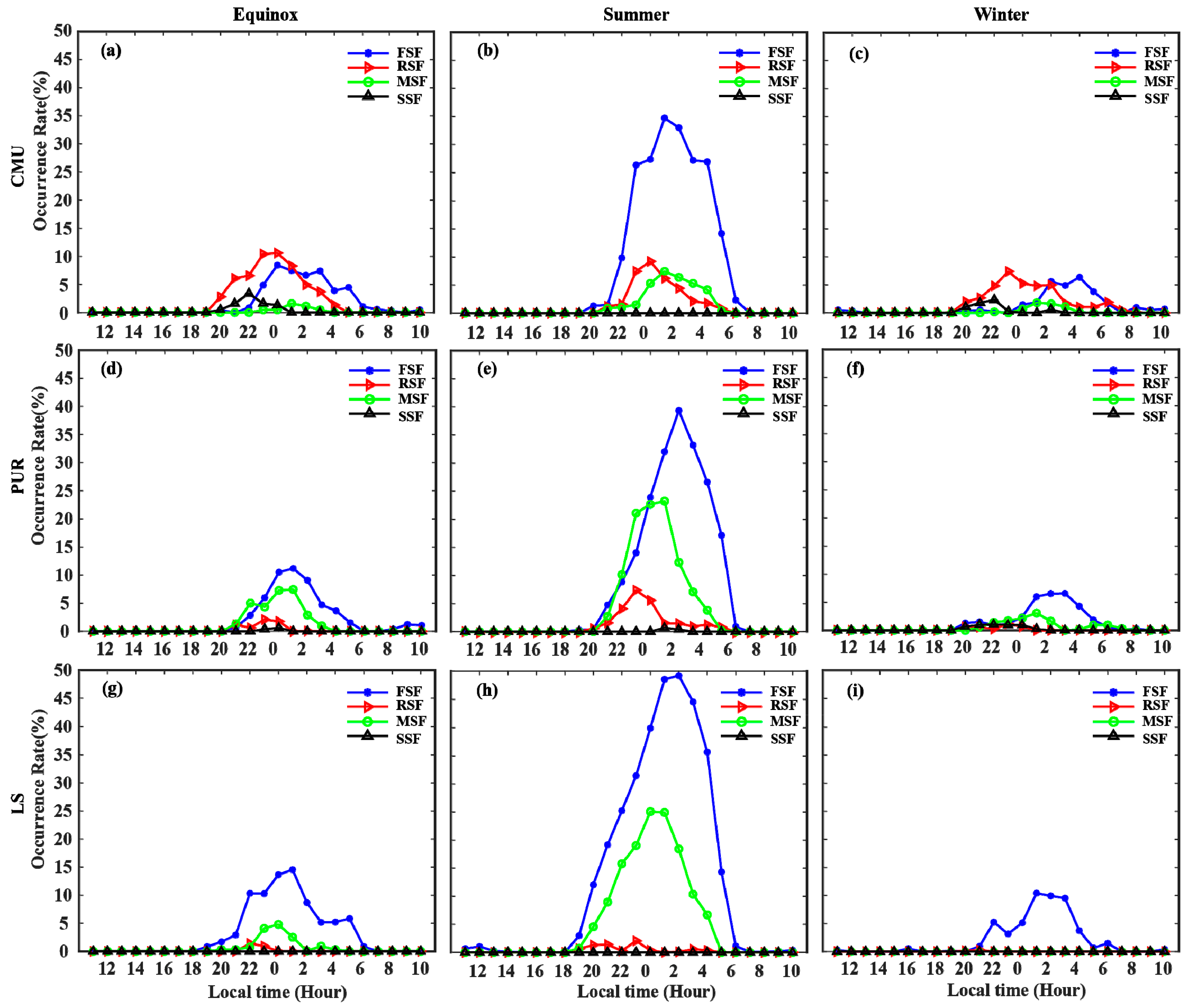
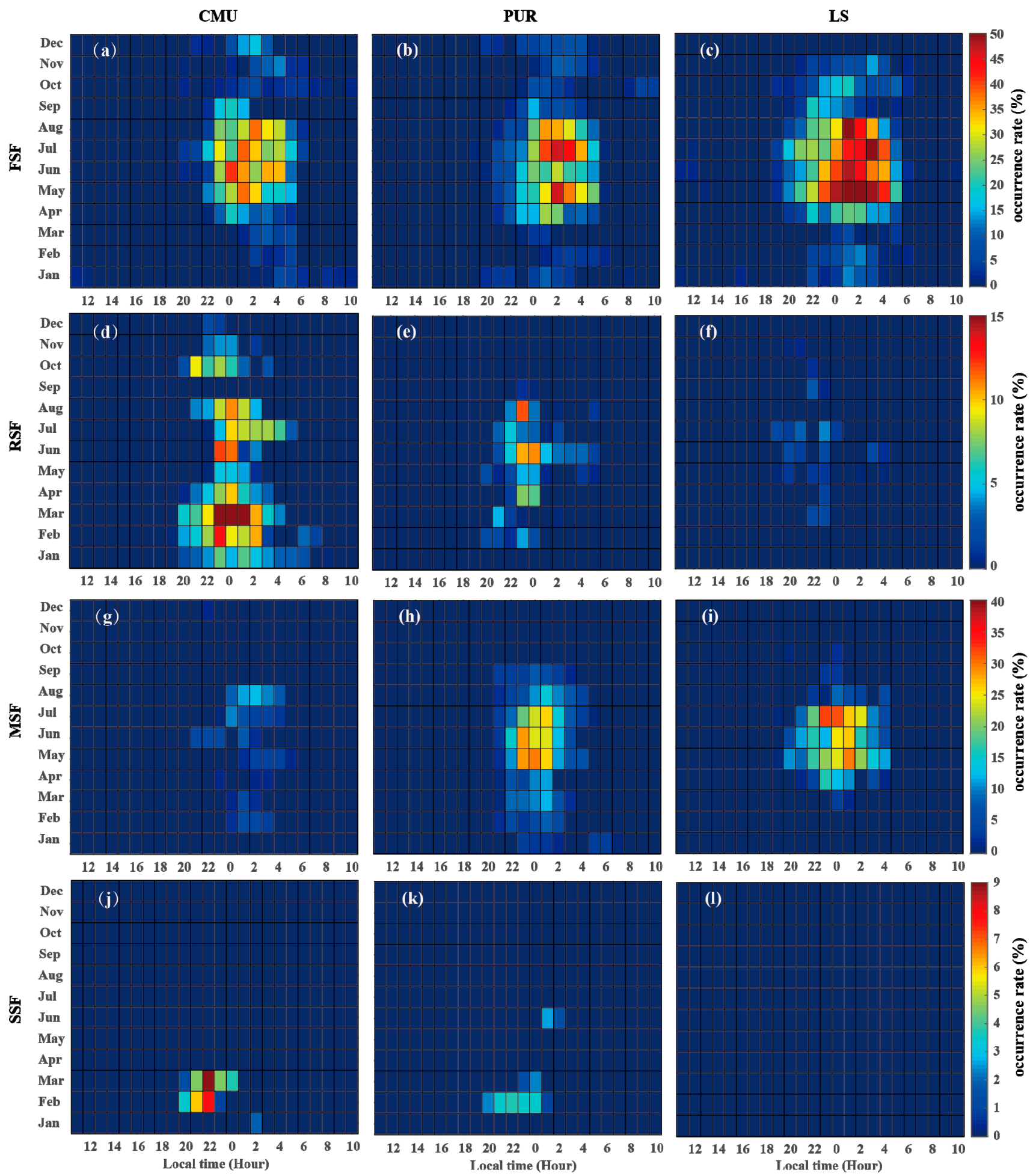

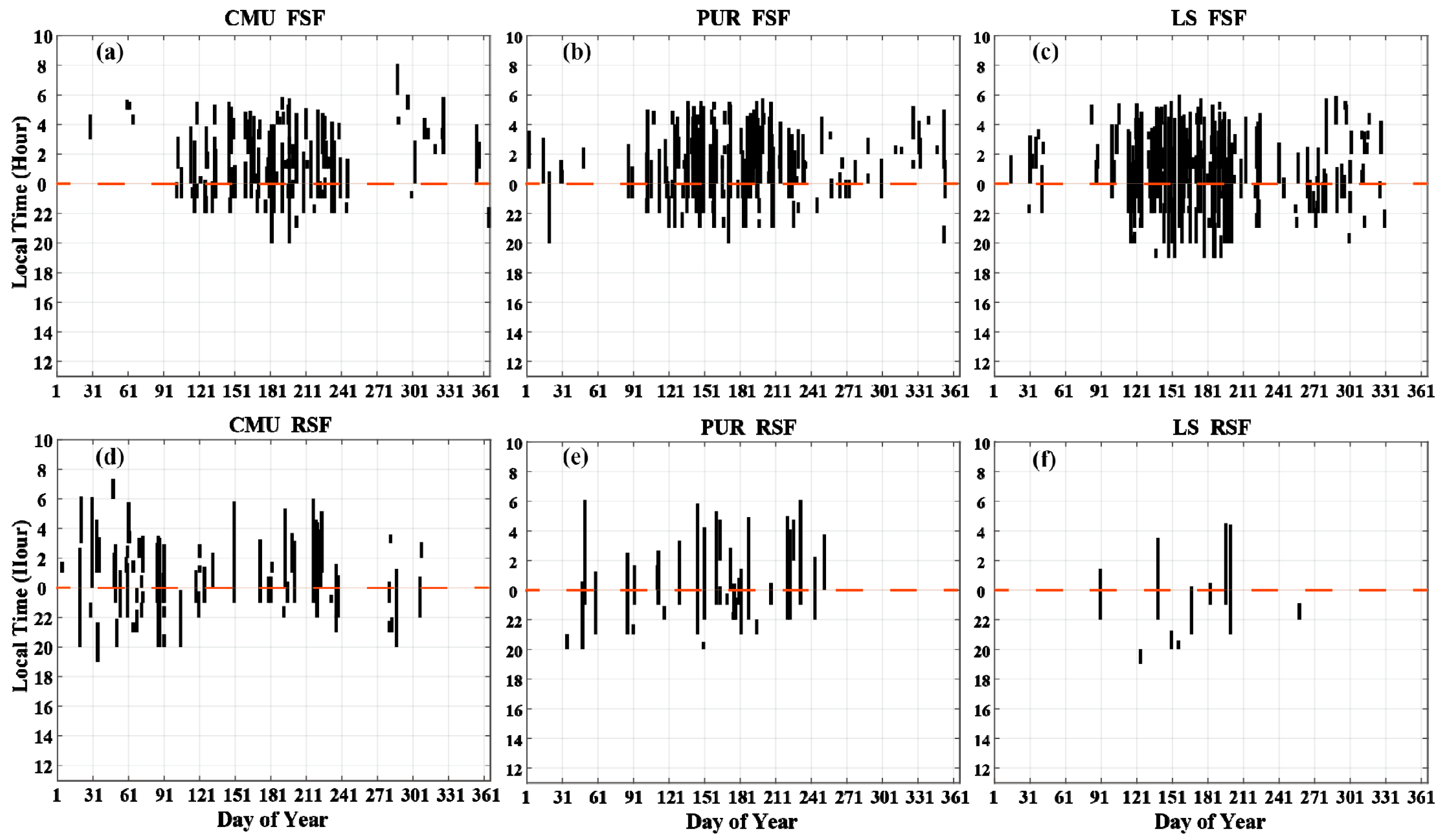
Publisher’s Note: MDPI stays neutral with regard to jurisdictional claims in published maps and institutional affiliations. |
© 2022 by the authors. Licensee MDPI, Basel, Switzerland. This article is an open access article distributed under the terms and conditions of the Creative Commons Attribution (CC BY) license (https://creativecommons.org/licenses/by/4.0/).
Share and Cite
Lan, T.; Jiang, C.; Yang, G.; Sun, F.; Xu, Z.; Liu, Z. Latitudinal Differences in Spread F Characteristics at Asian Longitude Sector during the Descending Phase of the 24th Solar Cycle. Universe 2022, 8, 485. https://doi.org/10.3390/universe8090485
Lan T, Jiang C, Yang G, Sun F, Xu Z, Liu Z. Latitudinal Differences in Spread F Characteristics at Asian Longitude Sector during the Descending Phase of the 24th Solar Cycle. Universe. 2022; 8(9):485. https://doi.org/10.3390/universe8090485
Chicago/Turabian StyleLan, Ting, Chunhua Jiang, Guobin Yang, Fei Sun, Zhenyun Xu, and Zhong Liu. 2022. "Latitudinal Differences in Spread F Characteristics at Asian Longitude Sector during the Descending Phase of the 24th Solar Cycle" Universe 8, no. 9: 485. https://doi.org/10.3390/universe8090485
APA StyleLan, T., Jiang, C., Yang, G., Sun, F., Xu, Z., & Liu, Z. (2022). Latitudinal Differences in Spread F Characteristics at Asian Longitude Sector during the Descending Phase of the 24th Solar Cycle. Universe, 8(9), 485. https://doi.org/10.3390/universe8090485






